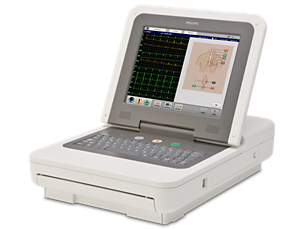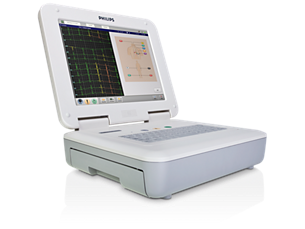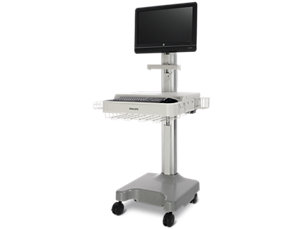- 16-Lead integrated analysis
-
16-Lead integrated analysis supports variety of patients
The Philips DXL ECG Algorithm goes beyond traditional 12-lead interpretation of the resting ECG. It also provides incremental diagnostic capabilities not associated with analysis programs of the past. 16-lead integrated analysis takes advantage of optional right chest and back electrodes to provide extended interpretations for adult chest pain. A 15-lead pediatric analysis is also supported. - ST Maps
-
ST Maps visualize deviations
ST Maps provide a visual representation of ST deviations in frontal and horizontal planes, responding to the 2009 AHA/ACCF/HRS Recommendations.* - Updated criteria
-
Updated criteria based on latest clinical research
The DXL 16-Lead Algorithm includes updated criteria based upon the most recent clinical research. Examples include the addition of “acute global ischemia” and incorporation of updated gender-specific STEMI criteria, as documented in the 2009 AHA/ACCF/HRS Recommendations.* - STEMI-CA criteria
-
STEMI-CA criteria to suggest occlusion site
Provides STEMI-CA (Culprit Artery) criteria to suggest the probable site of the occlusion, consistent with the 2009 AHA/ACCF/HRS Recommendations.* - Critical Value statements
-
Critical Value statements to speed delivery of urgent care
It supports Critical Value statements to highlight conditions requiring immediate clinical attention. Clinicians can quickly take action and reduce the time from the discovery of a critical cardiac event to intervention, such as balloon angioplasty. - LeadCheck program
-
LeadCheck program to prevent mistakes
The LeadCheck program identifies 19 possible lead reversal and placement errors during ECG acquisition. - Updated recommendations
-
Updated recommendations to support high quality standards
The algorithm reflects the updated guidelines and recommendations, such as the 2007 AHA/ACCF/HRS Recommendations Part II**, and the 2009 AHA/ACCF/HRS Recommendations Part VI1 for the Standardization and Interpretation of the ECG. This algorithm is available with a number of Philips products.***
16-Lead integrated analysis supports variety of patients
16-Lead integrated analysis supports variety of patients
ST Maps visualize deviations
ST Maps visualize deviations
Updated criteria based on latest clinical research
Updated criteria based on latest clinical research
STEMI-CA criteria to suggest occlusion site
STEMI-CA criteria to suggest occlusion site
Critical Value statements to speed delivery of urgent care
Critical Value statements to speed delivery of urgent care
LeadCheck program to prevent mistakes
LeadCheck program to prevent mistakes
Updated recommendations to support high quality standards
Updated recommendations to support high quality standards
- 16-Lead integrated analysis
- ST Maps
- Updated criteria
- STEMI-CA criteria
- 16-Lead integrated analysis
-
16-Lead integrated analysis supports variety of patients
The Philips DXL ECG Algorithm goes beyond traditional 12-lead interpretation of the resting ECG. It also provides incremental diagnostic capabilities not associated with analysis programs of the past. 16-lead integrated analysis takes advantage of optional right chest and back electrodes to provide extended interpretations for adult chest pain. A 15-lead pediatric analysis is also supported. - ST Maps
-
ST Maps visualize deviations
ST Maps provide a visual representation of ST deviations in frontal and horizontal planes, responding to the 2009 AHA/ACCF/HRS Recommendations.* - Updated criteria
-
Updated criteria based on latest clinical research
The DXL 16-Lead Algorithm includes updated criteria based upon the most recent clinical research. Examples include the addition of “acute global ischemia” and incorporation of updated gender-specific STEMI criteria, as documented in the 2009 AHA/ACCF/HRS Recommendations.* - STEMI-CA criteria
-
STEMI-CA criteria to suggest occlusion site
Provides STEMI-CA (Culprit Artery) criteria to suggest the probable site of the occlusion, consistent with the 2009 AHA/ACCF/HRS Recommendations.* - Critical Value statements
-
Critical Value statements to speed delivery of urgent care
It supports Critical Value statements to highlight conditions requiring immediate clinical attention. Clinicians can quickly take action and reduce the time from the discovery of a critical cardiac event to intervention, such as balloon angioplasty. - LeadCheck program
-
LeadCheck program to prevent mistakes
The LeadCheck program identifies 19 possible lead reversal and placement errors during ECG acquisition. - Updated recommendations
-
Updated recommendations to support high quality standards
The algorithm reflects the updated guidelines and recommendations, such as the 2007 AHA/ACCF/HRS Recommendations Part II**, and the 2009 AHA/ACCF/HRS Recommendations Part VI1 for the Standardization and Interpretation of the ECG. This algorithm is available with a number of Philips products.***
16-Lead integrated analysis supports variety of patients
16-Lead integrated analysis supports variety of patients
ST Maps visualize deviations
ST Maps visualize deviations
Updated criteria based on latest clinical research
Updated criteria based on latest clinical research
STEMI-CA criteria to suggest occlusion site
STEMI-CA criteria to suggest occlusion site
Critical Value statements to speed delivery of urgent care
Critical Value statements to speed delivery of urgent care
LeadCheck program to prevent mistakes
LeadCheck program to prevent mistakes
Updated recommendations to support high quality standards
Updated recommendations to support high quality standards
Documentatie
-
Productoverzicht (1)
-
Productoverzicht
- Philips DXL Algorithm Overview (7.0 MB)
-
Productoverzicht (1)
-
Productoverzicht
- Philips DXL Algorithm Overview (7.0 MB)
-
Productoverzicht (1)
-
Productoverzicht
- Philips DXL Algorithm Overview (7.0 MB)
Related products
Alternative products
-
PageWriter TC50
- Visual guidance to simplify ECGs
- Philips DXL ECG Algorithm expands diagnostic capabilities
- Automated reporting sequence saves time
- Lead placement aids accurate placement of leads on the patient
Product bekijken
-
PageWriter TC70
- Visual guidance to simplify ECGs
- Philips DXL 18-Lead ECG Algorithm expands diagnostic capabilities
- Automated reporting sequence saves time
- Lead placement aids accurate placement of leads on the patient
Product bekijken
-
ST80i
- Wireless design enhances patient mobility
- Intuitive user interface (GUI) simplifies workflow
- Flexible interoperability supports multiple connectivity options
- Sophisticated algorithms support confident diagnoses
Product bekijken
-
IntelliSpace ECG
- Custom set-up meets your individual needs
- Central access point simplifies ECG workflow
- Flexible design to reduce costs
- Scalable system to grow with you
Product bekijken
-
Device Management Dashboard
- Centralized device management
- Efficient fleet maintenance
- Web-based access serves your facility’s needs
Product bekijken
-
PageWriter TC50
The Philips PageWriter TC50 cardiograph is an advanced, reliable, and compact ECG solution, that is easy to use. The TC50 will help you meet your daily demands, giving you time to focus on your patients.
Product bekijken
-
PageWriter TC70
Philips PageWriter TC70 cardiograph is designed to simplify diagnostic ECG testing and streamline workflow – where an automated workflow and outstanding clinical support is critical.
Product bekijken
-
ST80i
Philips ST80i Stress Testing System opens up new paths for productivity & decision-making. Its wireless design, bi-directional connectivity, and advanced decision-making support tools enhance data review, patient care, and efficiency.
Product bekijken
Bekijk alle gerelateerde producten -
IntelliSpace ECG
Philips IntelliSpace ECG provides fast, easy access to ECGs from almost anywhere, anytime to enhance your workflow through extensive connectivity.
Product bekijken
-
Device Management Dashboard
The Philips Device Management Dashboard for PageWriter TC Cardiographs is a web-based tool that provides visibility to your PageWriter TC series devices from a single location for quick and efficient troubleshooting and device support, letting you remotely diagnose problems and view device statuses for select Philips cardiographs and patient monitors. You can view device configuration, location of last WLAN/LAN connection, wireless IP address and access point, enabled product options, and error log – all from your PC or mobile device.
Product bekijken
- 1 AHA/ACCF/HRS Recommendations for the Standardization and Interpretation of the Electrocardiogram, Part VI: Acute Ischemia/Infarction. Circulation 2009; 100:e262-e270.
- 2 AHA/ACCF/HRS Recommendations for the Standardization and Interpretaton of the Electrocardiogram, Part II: Electrocardiography Diagnostic Statement List. J Am Coll Cardiology, 2007:49:1128-135.
- 3 The DXL ECG Algorithm is available on the PageWriter TC70 and TC50 Cardiograph with the features and capabilities described above. The DXL Algorithm is also available on PageWriter TC30, TC20, and TC10; IntelliVue patient monitors; IntelliSpace ECG; and ST80i stress system with differentiated sets of features.





